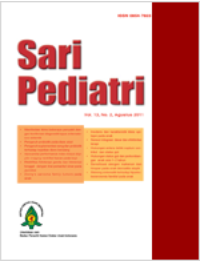Perbandingan Efek Live dan Heat-killed Probiotic Terhadap Penyembuhan Diare Akut Nondisentri pada Anak
Sari
Latar belakang. Diare akut masih menjadi penyebab morbiditas dan mortalitas, terutama di negara berkembang. Probiotik sebagai mikroorganisme hidup jika dikonsumsi dalam jumlah cukup akan memberikan manfaat terhadap tubuh pejamu. Namun masih terdapat masalah teknologi probiotik yang sulit diatasi, yaitu hilangnya dosis dan aktivitas yang tidak dapat diprediksi karena kualitas penyimpanan sediaan yang beragam. Heat-killed probiotic sudah mengalami tindalisasi menawarkan sediaan farmasi yang lebih stabil dengan aktivitas yang sama.
Tujuan. Menilai efektifitas heat-killed probiotic dibandingkan dengan live probiotic terhadap anak yang menderita diare akut nondisentri.
Metode. Uji klinis acak tersamar buta ganda terhadap pasien diare akut nondisentri usia 6-24 bulan dengan atau tanpa dehidrasi ringan-sedang di RS Hasan Sadikin, RSUD Ujung Berung dan RSUD Cibabat pada periode bulan April-Mei 2008. Setiap subjek mendapat satu bungkus berisi 3 x 1010 probiotic atau 107 live probiotic, kemudian dilanjutkan dengan interval 8 sampai 12 jam per hari selama lima hari. Durasi dan frekuensi defekasi dicatat secara kuantitatif. Analisis statistik dihitung dengan menggunakan uji t.
Hasil. Didapatkan 52 anak (25 heat-killed probiotic, 27 live probiotic) masuk ke dalam penelitian. Rata-rata durasi diare menurun secara bermakna pada pasien yang diberi heat-killed probiotic (50,2 jam SB 28,6) dibandingkan dengan live probiotic (74,8 jam SB 28,8) (p=0,003). Rata-rata frekuensi defekasi juga lebih rendah secara bermakna pada kelompok heat-killed probiotic dibandingkan dengan kelompok live probiotic (8,3;SB 7,4 vs 10,7;SB6,4).
Kesimpulan. Heat-killed probiotic lebih baik dalam mengurangi lama diare dan frekuensi defekasi daripada live probiotic pada anak pasien diare akut nondisentri.
Kata Kunci
Teks Lengkap:
PDFReferensi
Bryce J, Boschi-Pinto C, Shibuya K, Black R. WHO child health epidemiology reference group. WHO estimates of the causes of death in children. Lancet 2005;365:1147-52.
Department of Child and Adolescent Health and Development. The treatment of diarrhoea; a manual for physichians and other senior health workers. Geneva: World Health Organization, Genewa 2005.
Bhattacharya SK. Therapeutic methods for diarrhea in children. World J Gastroenterol 2000;6:497-500.
Departemen Kesehatan RI, Direktorat Jendral Pemberantasan Penyakit Menular dan Penyehatan Lingkungan Pemukiman. Buku ajar diare. Jakarta: Departemen Kesehatan RI; 1999.
Noel RJ, Cohen MB. Infectious diarrhea. Dalam: Wyliie, Hyams JH, penyunting. Pediatric gastroenterology and liver: pathophysiology/diagnosis/management. Edisi ke-3. New York: Saunders; 2006. h. 557-81.
Cama RI, Parashar UD, Taylor DN, Hickey T, Figueroa D, Ortega YR, dkk. Entropathogens and other factors associated with severe disease in children with acute watery diarrhea in Lima, Peru. JID 1999;179:1139-44.
Carneiro NB, Diniz-Santoz DR, Fagundes SQ, Neves LL, Reges RMB, Lima EKP, dkk. Clinical and epidemiological aspects of children hospitalized with severe Rotavirus-associated gastroenteritis in Salvador, BA, Brazil. BJID 2005;9:525-8.
Sudarmo SM. Peranan probiotik dan prebiotik dalam upaya pencegahan dan pengobatan diare pada anak. Prosidings Kongres Nasional II Badan Koordinasi Gastroenterologi Anak. Bandung Indonesia, 2003.
Kimoto H, Mitzumachi K, Okamoto T, Kurisaki J. New lactobacillus strain with immunomodulatory activity: Enhancement of Th1-type immune response. Microbiol Immunol 2004;48:75-82.
Supriatmo. Effectivity of live versus heat killed probiotic in children with acute diarrhea. Maj Kedok Nusantara 2006;4:391-6.
Nipat S, Vorapun P, Prayungari R, Chumnian K, Pisamai T, Wandee V. Clinical evaluation of the addition of lyophilized, heat-killed Lactobacillus acidophilus LB to oral rehydration therapy in treatment of acute diarrhea in children. J Pediatr Gastroenterol Nutr 2000;30:68-72.
Xiao S, Jiang SH, Liu HY, Wang GS, Xu GM, Zhang ZB. Multicenter, randomized, controlled trial of heat-killed Lactobacillus acidophilus LB in patients with chronic diarrhea. Advance Therapy 2003;20:253-60.
Matsuzaki T, Chin J. Modulating immune responses with probiotic bacteria. Immunol Cell Biol 2000;78: 67-73.
Torii A, Torii S, Fujiwara S, Tanaka H, Inagaki N, Nagai H. Lactobacillus acidophilus strain L-92 regulates the production of Th1 cytokine as well as Th2 cytokines. Allergol Intern 2007;56:293-301.
Corthesy B, Gaskins HR, Merceiner A. Cross-talk between probiotic bacteria and the host immune system. J Nutr 2007;137:781-90.
Galdeano CM, de LeBlanc AM, Viderola G, Bonet MEB, Perdigon G. Proposed model: mechanisms of immunomodulation induced by probiotic bacteria. Clin Vaccine Immunol 2007;14:485-92.
Chermesh I, Eliakim R. Probiotics and the gastrointestinal tract: where are we in 2005?. World J Gastroenterol 2006;12:853-7.
Khanna V, Alam S, Malik A. Efficacy of tyndallized Lactobacillus acidophilus in acute diarrhea. Indian J Pediatr 2005;72:935-8.
Kosim S, Waraouw S, Manoppo J, Gunawan S. Comparison between lived and tyndallized probiotic effectivities as therapy of acute diarrhea on children aged 4-60 months. Makalah lengkap PIT III IDAI. Yogyakarta, 2007.
Le Moal V, Davila ES, Servin AL. An experimental study and a randomized, double-blind, placebo-controlled clinical trial to evaluate the antisecretory activity of lactobacillus acidophilus strain LB against nonrotavirus diarrhea. Pediatrics 2007;120:795-803.
DOI: http://dx.doi.org/10.14238/sp10.5.2009.302-7
Refbacks
- Saat ini tidak ada refbacks.
##submission.copyrightStatement##
##submission.license.cc.by-nc-sa4.footer##
Email: editorial [at] saripediatri.org


Sari Pediatri diterbitkan oleh Badan Penerbit Ikatan Dokter Anak Indonesia
Ciptaan disebarluaskan di bawah Lisensi Creative Commons Atribusi-NonKomersial-BerbagiSerupa 4.0 Internasional.




